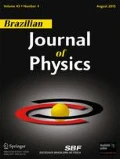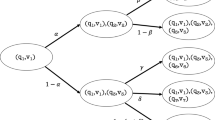Abstract
The generation of pseudo-random discrete probability distributions is of paramount importance for a wide range of stochastic simulations spanning from Monte Carlo methods to the random sampling of quantum states for investigations in quantum information science. In spite of its significance, a thorough exposition of such a procedure is lacking in the literature. In this article, we present relevant details concerning the numerical implementation and applicability of what we call the iid, normalization, and trigonometric methods for generating an unbiased probability vector p=(p 1,⋯ ,p d). An immediate application of these results regarding the generation of pseudo-random pure quantum states is also described.






Similar content being viewed by others
References
D.J. Bennett. Randomness (Harvard University Press, Cambridge, 1998)
L. Mlodinow. The Drunkard’s walk: How randomness rules our lives (Pantheon Books, New York, 2008)
M. Bell, K. Gottfried, M. Veltman. John Bell on the foundations of quantum mechanics (World Scientific, Singapore, 2001)
M.H. DeGroot. Probability and statistics (Addison-Wesley, Reading, 1975)
E.T. Jaynes. Probability Theory: The Logic of Science (Cambridge University Press, New York, 2003)
D.P. Landau, K. Binder. A guide to Monte Carlo simulations in statistical Physics (Cambridge University Press, Cambridge, 2009)
T.M. Cover, J.A. Thomas. Elements of Information Theory (Wiley, New Jersey, 2006)
M.A. Carlton, J.L. Devore. Probability with Applications in Engineering, Science, and Technology (Springer, New York, 2014)
H.V. Ribeiro, E.K. Lenzi, R.S. Mendes, G.A. Mendes, L.R. da Silva, Symbolic sequences and Tsallis entropy. Braz. J. Phys. 39, 444 (2009)
Á.L. Rodrigues, M.J. de Oliveira, Continuous time stochastic models for vehicular traffic on highways. Braz. J. Phys. 34, 1 (2004)
F.J. Resende, B.V. Costa, Using random number generators in Monte Carlo simulations. Phys. Rev. E. 58, 5183 (1998)
K.C. Mundim, D.E. Ellis, Stochastic classical molecular dynamics coupled to functional density theory: Applications to large molecular systems. Braz. J. Phys. 29, 199 (1999)
M.A. Nielsen, I.L. Chuang. Quantum Computation and Quantum Information (Cambridge University Press, Cambridge, 2000)
M.M. Wilde. Quantum Information Theory (Cambridge University Press, Cambridge, 2013)
J. Maziero, R. Auccaise, L.C. Celeri, D.O. Soares-Pinto, E.R. deAzevedo, T.J. Bonagamba, R.S. Sarthour, I.S. Oliveira, R.M. Serra, Quantum discord in nuclear magnetic resonance systems at room temperature. Braz. J. Phys. 43, 86 (2013)
A. Peres. Quantum Theory: Concepts and methods (Kluwer, New York, 2002)
J.J. Sakurai, J. Napolitano. Modern Quantum Mechanics, 2nd edn (Pearson education, San Francisco, 2011)
J. Grondalski, D.M. Etlinger, D.F.V. James, The fully entangled fraction as an inclusive measure of entanglement applications. Phys. Lett. A. 300, 573 (2002)
R.V. Ramos, Numerical algorithms for use in quantum information. J. Comput. Phys. 192, 95 (2003)
D. Girolami, G. Adesso, Observable measure of bipartite quantum correlations. Phys. Rev. Lett. 108, 150403 (2012)
D. Girolami, G. Adesso, Quantum discord for general two-qubit states: Analytical progress. Phys. Rev. A. 83, 052108 (2011)
J. Batle, M. Casas, A.R. Plastino, A. Plastino, Entanglement, mixedness, and q-entropies. Phys. Lett. A. 296, 251 (2002)
J. Batle, A.R. Plastino, M. Casas, A. Plastino, On the entanglement properties of two-rebits systems. Phys. Lett. A. 298, 301 (2002)
J. Batle, M. Casas, A. Plastino, A.R. Plastino, Maximally entangled mixed states and conditional entropies. Phys. Rev. A. 71, 024301 (2005)
M. Roncaglia, A. Montorsi, M. Genovese, Bipartite entanglement of quantum states in a pair basis. Phys. Rev. A. 90, 062303 (2014)
S. Vinjanampathy, A.R.P. Rau, Quantum discord for qubit–qudit systems. J. Phys. A: Math. Theor. 45, 095303 (2012)
X.-M. Lu, J. Ma, Z. Xi, X. Wang, Optimal measurements to access classical correlations of two-qubit states. Phys. Rev. A. 83, 012327 (2011)
F.M. Miatto, K. Piché, T. Brougham, R.W. Boyd, Recovering full coherence in a qubit by measuring half of its environment, arXiv:1502.07030
J. Shang, Y.-L. Seah, H.K. Ng, D.J. Nott, B.-G. Englert, Monte Carlo sampling from the quantum state space. I. New J. Phys. 17, 043017 (2015)
Y.-L. Seah, J. Shang, H.K. Ng, D.J. Nott, B.-G. Englert, Monte Carlo sampling from the quantum state space. II. New J. Phys. 17, 043018 (2015)
G.W. Stewart, The efficient generation of random orthogonal matrices with an application to condition estimators. SIAM J. Numer. Anal. 17, 403 (1980)
K. życzkowski, M. Kuś, J. Phys. A. Math. Gen. 27, 4235 (1994)
E. Brüning, H. Mäkelä, A. Messina, F. Petruccione, Parametrizations of density matrices. J. Mod. Opt. 59, 1 (2012)
J. Emerson, Y.S. Weinstein, M. Saraceno, S. Lloyd, D.G. Cory, Pseudo-random unitary operators for quantum information processing. Science. 302, 2098 (2003)
V. Vedral, M.B. Plenio, Entanglement measures and purification procedures. Phys. Rev. A. 57, 1619 (1998)
K. życzkowski, P. Horodecki, A. Sanpera, M. Lewenstein, Volume of the set of separable states. Phys. Rev. A. 58, 883 (1998)
T. Radtke, S. Fritzsche, Simulation of n-qubit quantum systems. IV. Parametrizations of quantum states, matrices and probability distributions. Comput. Phys. Comm. 179, 647 (2008)
M. Matsumoto, T. Nishimura, Mersenne Twister: A 623-dimensionally equidistributed uniform pseudorandom number generator. ACM Trans. Model. Comput. Sim. 8, 3 (1998)
M. Wahl, M. Leifgen, M. Berlin, T. Röhlicke, H.-J. Rahn, O. Benson, An ultrafast quantum random number generator with provably bounded output bias based on photon arrival time measurements. Appl. Phys. Lett. 98, 171105 (2011)
J.A. Miszczak, Employing online quantum random number generators for generating truly random quantum states in Mathematica. Comput. Phys. Comm. 184, 257 (2013)
Acknowledgments
This work was supported by the Brazilian funding agencies: Conselho Nacional de Desenvolvimento Científico e Tecnológico (CNPq) and Instituto Nacional de Ciência e Tecnologia de Informação Quântica (INCT-IQ). We thank the Group of Quantum Information and Emergent Phenomena and the Group of Condensed Matter Theory at Universidade Federal de Santa Maria for stimulating discussions. We also thank the Referee for his(her) constructive comments.
Author information
Authors and Affiliations
Corresponding author
Rights and permissions
About this article
Cite this article
Maziero, J. Generating Pseudo-Random Discrete Probability Distributions. Braz J Phys 45, 377–382 (2015). https://doi.org/10.1007/s13538-015-0337-8
Received:
Published:
Issue Date:
DOI: https://doi.org/10.1007/s13538-015-0337-8




